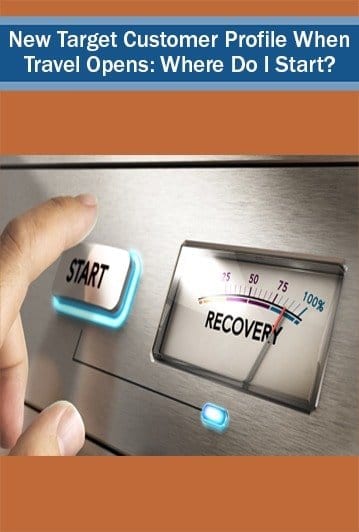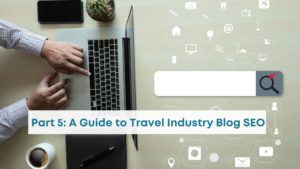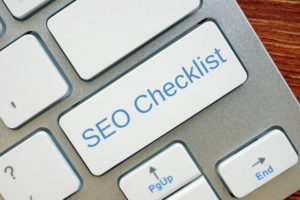
Tourism has changed forever. Three important areas have forced us all to relook at our companies because the travelers’ needs and perspectives have changed and we have to reach them- somehow.
These factors are travel restrictions, fear and uncertainty, and price sensitivity. These factors force us to relook at our target customer profile – for some of you the customer will have to be different, for others – we need to market to our current customers differently.
3 Important Factors to Address In Your Marketing
1.Travel restrictions, regulations and uncertainty:
a) The staggering of domestic and international flights vary by country and some countries are not permitting some countries passengers to enter.
–Perhaps International tourism hasn’t even opened yet? And who is to say that travelers will start rushing to your country when it opens? They are managing their own country’s restrictions and their own fears of the unknown.
b) To make matters worse – some travelers are not permitted to enter certain countries, due to the stage and development of the virus. We’ve seen this already with Americans unable to enter parts of Europe.
-As restrictions relax and we learn to live with the new normal, where does this leave tourism and hospitality services for travelers? Will tourism be regarded as an essential or non-essential service if restrictions and closures continue as cases increase?
c) Protocols and regulation uncertainty – Frustrated travelers are finding it nearly impossible to understand what countries they can enter, what protocols they need to follow, and what tests or quarantine steps they need to take. This is stopping them from booking. They are looking for safe options – like traveling in their home country.
d) Travel Insurance restrictions – Insurance companies haven’t made it easy for anyone to travel. Some don’t cover Covid if you get sick outside your home country, while others won’t cover people from countries that have reported travel advisories. Again, making it impossible for travelers to book a trip easily.
Implications for your business: Now is the time to take a good look in the mirror. These obstacles are going to continue. You relook at your target customer profile and access whether you need to target a new group of consumers (which in many cases are domestic and regional travelers or just LOCALS) As travel restrictions continue, lack of widespread and valid testing, and the absence of a vaccine, international travel will be restricted from various countries in stages. This may require you to create something specifically for this target audience.
2. The needs of travelers have changed – fear and uncertainty prevails
We are changing as humans because of the impact this virus has on us. Fortunately, many research studies have evaluated the mindset of consumers and how and where they want to travel. Here are a few highlights:
- Even when air travel continues – Every travel business will need to reassure safety and cleanliness to worried passengers –70% of Americans, and 54% of travelers surveyed from the U.K. associate air travel are worried about getting sick. Modifications to air travel procedures will need to be made for these travelers to get on a plane again. The same fear and uncertainty as we are seeing apply to hotels, buses, and cruise ships. 2020 Phocuswright Study
- Values for many travelers will change – Our values will shift from a focus on image and luxury to values of safety and responsiveness. Companies must focus on a clean and safe environment, and responding quickly to issues, and clearly communicate this in their marketing in order to build trust with their guests. As well, nature and outdoors is the prevailing need and desire. What can you do to help consumers with these needs? –April 2020 Smart travel lab – Kantar
- Local travel and staycations have accelerated – Regulation, fear, and cabin fever have driven travelers to focus on getting away from the main city centers into nature and controlling their surroundings and often driving their own care. This approach gives travelers a sense of control and reduces anxiety from the fear of infection.

The changing values and trends of consumers during and post Covid.
Implications for your business:
Relook at your target audience, and what you offer them now. How can you eliminate their fears of getting sick? How can you tell and show them how you take their concerns very seriously?
You will need to change your copy and communications to meet their needs.
Contact your tourism board to get information and data on the type of consumers that are traveling to your area? What do they like, what do they want to do? Monitor what countries are opening up to see how they are managing shifts in perspectives. If your primary target customer profile is from the U.K., but the borders remain closed to your country – this will force you to target different people from different countries, and potentially a local market in the near term. What can you offer them?
Not sure how to change your communication and website copy? Here are some ideas here.
3. Price Deals and Price Sensitivity of Travelers
Pricing is going to change in the short term and long term in travel because of several major factors:
– Widespread job loss and income will make travelers more cautious in the short term and it will impact how much they are willing to pay; for instance a staycation in their home country and shorter trips will be more palatable than longer, luxury, and international excursions. Some travelers will ‘wait and see’ due to health fears and choose shorter and closer trips and the demand will change. This shift will also have an impact on costs.
– Tourism companies and airlines are advertising crazy low prices in the short term – They are desperate to get travelers back after travel is open again. This activity will be short term. It will be impossible to sustain low pricing long term in a low margin industry like tourism.
–Longer-term, the impact of the bankruptcy of airlines, hotels, and attractions will drive up costs, and if regulations and safety require them to book fewer people for their services to satisfy distancing measures, costs for travel companies will increase. Unfortunately, travel will most likely become more expensive vs. pre-COVID, and it will not remain accessible for everyone. To add to the challenge, the virus has caused a deep financial crisis, and the disposable income for many travelers will not improve for some time.
Implications for your business:
Pay close attention to the price sensitivity in the market, how it will change, and do your research on pricing comparisons.
Don’t assume that low prices is what all travelers are willing to pay. This is not true. In fact in a study by Amadeus Sept 2020 , 70% of travelers expect to have the same or more budget for holidays.
We may see short term discounts, but they will level off. Lower pricing will not win in the long run. The more you stay in touch with the market dynamics, the better you can manage your profits of your business. My bigger questions is: What will the future of luxury tourism look like?
Understanding the new needs of your post COVID guest is critical. If you don’t understand the needs of your guest, you can’t effectively market to them.The more you can persuade them, the more of a chance they will buy from you.
Do you need to develop a new target customer profile Post-CoVID-19? – probably.
All the factors mentioned above will require tourism businesses to look at their target audiences. Most likely you will need to shift to a new audience, at least in the short term.
Here are some new target customer profiles to think about:
a. Local daytrippers, domestic instead of International travelers. – We’ve seen this in many countries that opened up in May onward. Consumers are uncertain about regulations and have a fear of traveling too far, and if your target market was traditionally foreign,a domestic target could vary in language, and in different needs. Local travelers may like to do different things, and pricing may be different. For example: If you historically offered a city tour, a local traveler may more likely book an adventure that is not easily accessible, and not somewhere they can get to in their own car. Do you have a few packages, rooms, or attractions to appeal to them?*
There are different subgroups within the domestic traveler to consider:
b. Families with kids – It’s a guarantee that some parents will want to unleash their kids to enjoy some activities that they don’t have to organize, manage, or monitor. And after being trapped indoors – nature and the outdoors will play a key role in their travel decision. This is particularly relevant for local travelers – and they may want to bring their dogs too.
c. Retired and semi- retired travelers -This group will either be very worried by the crisis, and will wait and see what happens for several months OR they will be the first ones on the next plane because to them “life is too short, let’s go traveling again.” As long as you provide offers relevant to them (i.e. cultural and low impact adventures). This group over-index on the use of Facebook, and you can target them easier with ads, based on their demographics and key brands they use.
d. Expats and digital nomads – There are groups of foreigners who may be an option to target since they are already in the country and looking for something to do. For example, I live in Medellin Colombia right now, which is a hotspot for retirees, as well as startup companies as well as individuals and groups who live and work online here. A lakeside hotel in a nearby town advertised their services with a call to action “Come stay and recharge in nature after the quarantine” – and they received hundreds of responses and bookings. Don’t forget that local Facebook expat and digital nomad groups are a great place to find prospective buyers. (just check their rules for promoting).
e. Students– The younger generations are having a tough time coming to terms with their canceled plans, and they aren’t spending money like they used to, as they are cooped up at home. In some studies, this group will be the most anxious to say YES! to travel quickly after the crisis is over. Think about December when many students will be out of school – how can you create a plan to target them now?
f. The Business Community – There is no doubt that many companies are challenged to bring their businesses online and work from home. Now, in September we continue to see many businesses have not returned to their offices, and they do not have any scheduled group business events. Cities around the world are missing the extensive income generated from these offsite business meetings. However, are their opportunities to reach out to local businesses – to create a safe, physically distanced event, tour, meeting to bring the team together? Also, reach out to past contacts to remind them of the future opportunity to work with you again.
g. Occasion: Communicate the needs and emotions of missed celebrations – Not only should you look at target groups, but also look at occasions to market. Many celebrations have been missed by travelers – like graduations, birthdays, anniversaries, weddings and reunions – marketing directly to consumers who have missed these occasions can be very useful to tap into their needs and their emotions. Facebook can be a very effective tool to advertise to people on these occasions because you can directly target past birthdays, engaged, and anniversaries within the targeting functions.
*Thanks for the opinions and views from the Covid study from Toluna/Harris Interactive April 2020, – Digital Tourism Show, and Arival Webinar April 21 tourism insights
How do I start defining a new target market and ideal customer profile?
Here are the key steps:
1. Brainstorm. Start with your own best guess
– Think of as many people that you could attract to your business. It could be someone you met before, a neighbor, or it could be a friend of a friend that would have some interest in your services. It could be a past guest you had and you know if you had more of them, it would help your business. OR maybe you could make changes to your product or service that would be of interest to them.
2. Review your list and pick 3-4 of the most viable people
No business appeals to everyone. Nor do you need to sell to everyone. Now think through in more detail about these people. Most importantly think about their behaviors. What do they like to do? What are their interests? What do they want to do now to feel safe, comfortable, stress free? Can you offer them an escape outdoors, to nature? Offer a weekend getaway from the city? Write as many things as you can about this person – who are they, what do they do?, what do they worry about, what can you do to help them in some way?
3. Interview these people to validate your guesses, AND learn more about them.
Yes. you have to ASK people questions in order to understand them. Contact that neighbor, that friend of a friend, some past guests that you know — and ask them specific questions. You will be amazing by how much you will learn about them!
Set up a call and ask these questions from this questionnaire. (download here)
You will ask questions about their background, Their likes and dislikes, Their Interests, Their “pain” – these are the problems you can resolve for them, How they plan their travel, what activities do they like to do, and what do they need to feel safe and comfortable using your products or services.
Summarize this information in a little chart. One page for each potential guest. You can summarize this in different ways.
Why: This acts like a vision board, or a goal posted on your bulletin board — This will help you hone in on this person, think about them, how to market to them, and share this information to your staff. Your staff and partners can also add to this summary, to help you better attract them.
You can do this in several ways.
– Use software to create it. Like Uxpressia.
– or use our simplified target guest powerpoint template (download here)
A guest persona will make your life much easier because it will help you develop:
–Website Copy
-Facebook and social media posts
-Media content
-Better customer service responses to your guests
-Email marketing that doesn’t get deleted
–Advertising and sales materials
–Tours, or amenities you offer, the types of events you run
5. Important points about your ideal target customer profile
- Often mindset, interests, and behaviors will be a more significant factor than their demographics (age, what country they are from) to appealing to this consumer.
- Don’t get caught up with a specific age (range)
- Focus on the person with the mindset, attitude and the stage they are in
Download the resources, and start working on your new target customer profile. How did you make out with your new guest persona? Let us know, and you can find more tourism marketing resources here.








